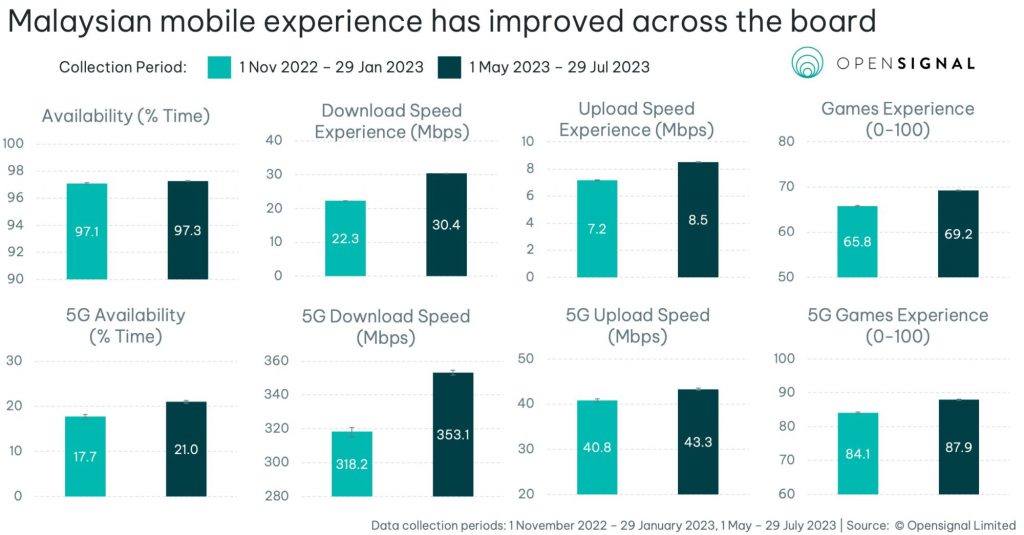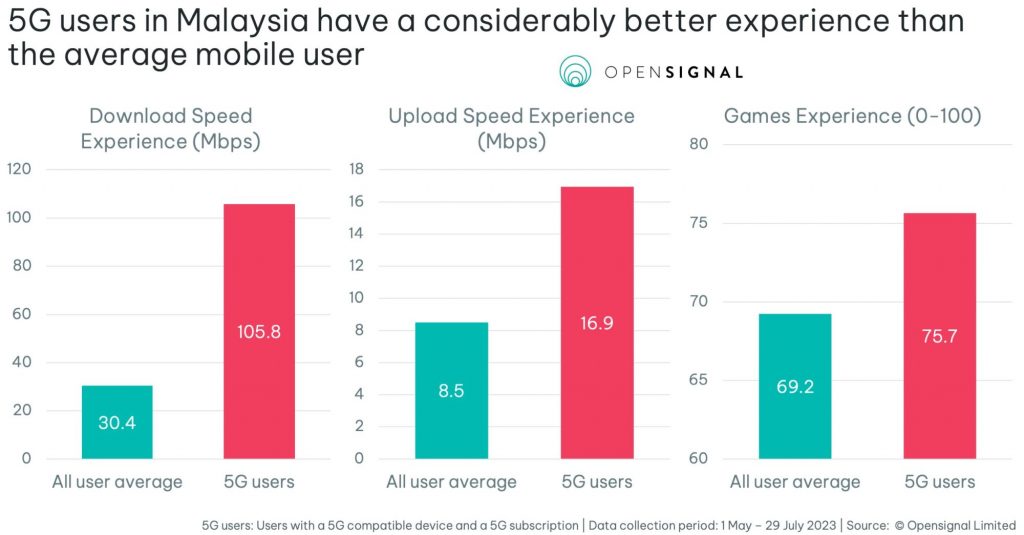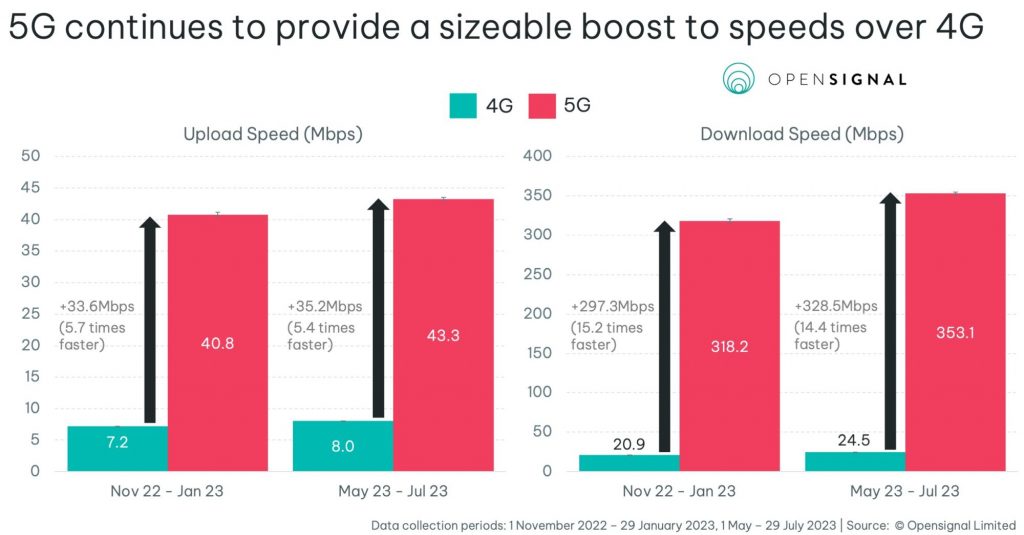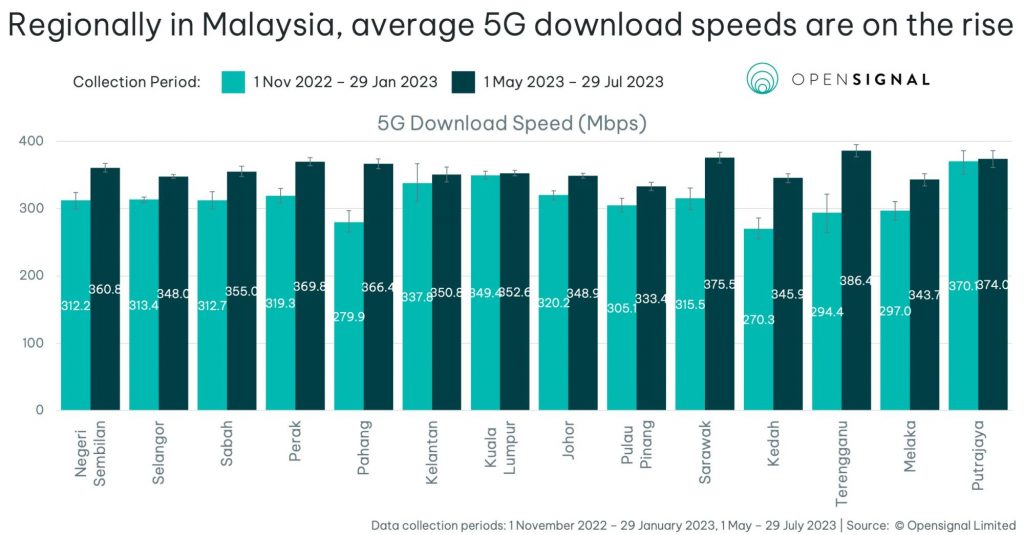Malaysia’s 5G network via Digital Nasional Berhad has been switched on for almost two years now and all telcos including Maxis are finally on board with the single wholesale network. Opensignal has published its latest report which provides a clearer picture of the national 5G network’s performance and user experience so far.

Comparing the three-month periods between 1st November 2022 to 29 January 2023 with 1st May 2023 to 29th July 2023, they have found that Malaysia mobile users are seeing a slight increase in 5G availability from 17.7% to 21%. This means Malaysian 5G users are connected to the 5G network 21% of the time and the remaining 79% of the time are on 4G.
In terms of 5G download performance, there’s an uplift in download speed from 318.2Mbps to 353.1Mbps while upload speed has gotten a slight increase from 40.8Mbps to 43.3Mbps. When it comes to the 5G Games experience, there’s an improvement from 84.1 points to 87.9 points.

The benefits of 5G for mobile usage are clear when the stats of 5G users are compared to an average mobile user. As shown above, the download speed experience is more than 3x higher while the upload speed is 2x. Meanwhile, the gaming experience is slightly higher by 6.5 points. With 75.7 points, the mobile gaming experience is categorised as “good” where users get immediate feedback between action and game outcomes and experience little to no delay on their inputs.

As more Malaysians are gradually turning on 5G on their devices, there’s also a noticeable increase in 4G performance as shown above. 4G downloads have increased from an average of 20.9Mbps to 24.5Mbps while upload speed has also increased slightly from 7.2Mbps to 8.0Mbps. This could be contributed by the ongoing 4G network upgrades and more data-heavy users have started to transition to 5G which helps to reduce congestion on 4G.

As of the end of July 2023, DNB’s 5G network has achieved 66.8% population coverage and it aims to achieve 80% by the end of this year. Looking at the individual state breakdown, there’s an improvement of 5G speeds with all states delivering above 300Mbps. The states of Pahang, Kedah, Melaka and Terengganu recorded less than 300Mbps downloads in the previous 3-month period. Opensignal said Terengganu saw the most improvement of 91.9Mbps between the two 3-month periods.

One of the major metrics for 5G is its availability where it measures how often a user is connected to the 5G network. Despite having 90% 5G population coverage in the Klang Valley, 5G availability is hovering around 21.8-25.4% for Selangor, Kuala Lumpur and Putrajaya. Interestingly, Putrajaya’s 5G availability dipped from 27.9% to 25.4%. This tells us that indoor 5G coverage is still lacking and population coverage is not a clear representation of 5G availability.
Outside of the Klang Valley, Johor has the next highest 5G availability at 21.5%, followed by Pulau Pinang at 19.0%, Negeri Sembilan at 18.8% and Sabah at 18%. 5G availability in other states is below 18% and the lowest is Kelantan at only 10.8%.
To increase 5G adoption, the government has announced Pakej 5G Rahmah which aims to provide affordable 5G plans and new 5G phone bundles. Communications and Digital Minister said last week that DNB will be making several major announcements including the appointment of a new CEO but there has been no new updates at the moment.
Related reading
- Customers paying “DNB Tax” for 5G? Here’s DNB’s response
- DNB to announce new CEO tomorrow? 5 telcos to finalise their equity stake in DNB?
- Rahmah for Civil Servants: Government staff to get RM120 subsidy for their postpaid plan
- Pakej 5G Rahmah: 60GB 5G data for RM60/month, 5G phones from RM120 available from 31 Aug
Opensignal: Malaysian 5G users are connected to 5G network 21% of the time
News Reports PH
0 Comments